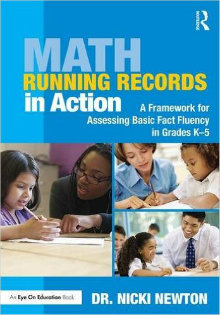Making Sure Students Master Math Facts
Math Running Records In Action: A Framework for Assessing Basic Fact Fluency in Grades K-5
By Dr. Nicki Newton
(Routledge/Eye On Education, 2016 – Learn more)
 Reviewed by Rita Platt
Reviewed by Rita Platt
Do students have to memorize basic math facts to be successful? That is a question that has been debated heartily since the implementation of the Common Core State Standards for Mathematics swept the nation.
 Not too long ago, the controversy erupted at my school. Teachers had attended a professional development session at which the trainer vehemently rejected the idea of fact mastery (at least that is how the teachers interpreted what she said).
Not too long ago, the controversy erupted at my school. Teachers had attended a professional development session at which the trainer vehemently rejected the idea of fact mastery (at least that is how the teachers interpreted what she said).
Concerns about teaching math facts
Teachers came back with lots of questions. Did our students need to memorize? Should we used timed tests? What were other schools doing? What should we do? To make matters even more confusing, we had just adopted a new Common Core aligned math series that felt overwhelming to teachers, seemed to deluge students with strategies, and confounded parents.
Let’s be honest, getting kids to complete fact fluency is hard! Who has the time in school? How can we get kids to practice at home? What teacher hasn’t wanted to throw in the towel?
Together the teachers at my school decided that we simply could not do that. Instead, we made it the focus of our school improvement plan. Together, we would learn to better engage students in work with math facts. But we didn’t know how. We still had lots of questions.
An easy-to-use framework
Now, thanks to Math Running Records by Dr. Nicki Newton, we have many answers too! This easy-to-read book offers a helpful framework for assessing, teaching and practicing math facts. I am not overstating when I say that this book was a revelation to me.
Newton insists that children must know addition, subtraction, multiplication, and division facts with fluency, meaning automaticity. But this is not enough, she says.
“We want our students to know what the goal is, to know [facts] without even thinking about it”… but “That is not the only goal, nor is it the most important one” (p. 75).
Newton very convincingly explains that students must understand how and why math facts work rather than just memorizing them.
Her book offers five levels of fact knowledge (p. 50):
0 – The student is unable to solve the fact.
1 – The student can solve using physical counting strategies.
2 – The student can solve the fact using mental and/or verbal strategies.
3 – Student uses related fact strategies (for example, doubles plus one to solve 8+9).
4 – Student has automatic retrieval of fact.
Detailed plans for assessing students’ knowledge
The bulk of the text is comprised of four chapters, one each for addition, subtraction, multiplication, and division. Newton shares detailed plans for assessing students’ knowledge of each fact using a system similar to the running records that reading teachers have used for decades. Her tools include coding systems that allow teachers to gain deep knowledge of how a given student approaches math facts. She helps teachers frame that knowledge around four questions (p.58).
- Does the student understand the type of fact s/he is asked to solve?
- What strategies does the student use?
- Does the student use any ineffective or inefficient strategies?
- What doe the student do when s/he doesn’t know a fact?
After sharing the specifics of the running records in each chapter, she then offers myriad strategies for initial teaching of facts and for intervention when students need it. However, unlike the many new math curriculums purchased by schools, she warns,
Teaching 15 strategies just to teach 15 strategies doesn’t make any sense…the emphasis should be on how thinking flexibly in mathematical ways helps us to approach problems strategically and efficiently” (p. 247).
Student agency in learning facts is critical
Newton drives home the idea that student agency in learning facts is critical. She eschews the practice of giving students timed tests – instead recommending that teachers give “Just Knew It” untimed quizzes with short lists of facts. Newton emphasizes that students must learn to evaluate their own knowledge, set goals, make plans to improve, and take ownership of their learning in general.
What is so great about the book is less about the actual tools it offers (though they are helpful) and more about how it reframes the way some teachers think about math. Maybe it’s even better to say that I loved this book because of how it taught me to take note of how students think about math.
The minute I read the last page of Math Running Records in Action, I bought copies for all of the PLC leaders at my school. I believe this book will help us meet our school improvement goals for math facts. Could there be higher praise than that?
Rita Platt (@ritaplatt) is a National Board Certified Teacher with master’s degrees in reading, library, and leadership. Her experience includes teaching learners in remote Alaskan villages, inner cities, and rural communities. She currently is a teacher-librarian, teaches graduate courses for the Professional Development Institute and writes for We Teach We Learn.

































